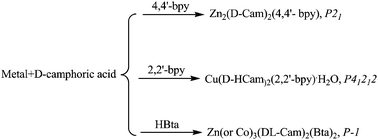In this work, based on the chiral source of D-camphoric acid (D-H2Cam), the effect of configurational rigidity of N-donor co-ligands on the crystallization chiral or achiral metal–organic compounds is explored. Firstly, the somewhat flexible N-donor ligand of 4,4′-bipyridine (4,4′-bpy) in conjunction with chiral D-camphoric acid and Zn(II) ions yields compound 1, Zn2(D-Cam)2(4,4′- bpy) (1), which crystallizes in the chiral P21 space group and shows the 3D six-connected self-penetrating net so-called LB-1 with the 446108 Schläfli symbol. Afterwards, the replacement of 4,4′-bpy and Zn(II) ions by the relatively less flexible N-donor ligand of 2,2′-bipyridine (2,2′-bpy) and Cu(II) ions produces compound 2, Cu(D-HCam)2(2,2′-bpy)·H2O, which crystallizes in the chiral P41212 space group and holds the 3D supramolecular (3,6)-connected net labelled as rutile with the (462)(4261083) Schläfli symbol. Lastly, the completely rigid N-donor ligand of benzotriazole (BtaH) is used, resulted in compound 3 and 4, namely Zn3(DL-Cam)2(Bta)2 and Co3(DL-Cam)2(Bta)2. Compounds 3 and 4 are isostructural and crystallize in the achiral P![[1 with combining macron]](http://www.rsc.org/images/entities/char_0031_0304.gif) space group with the chiral D-camphorate ligand racemized. The structure feature of them is 2D net built on {Zn3(CO2)4 (Bta)2}n or {Co3(CO2)4(Bta)2}n rod-like building blocks. Moreover, the magnetic studies of 4 disclose a weak antiferromagnetic behaviour that is further interpreted by the non-critical scaling theory.
space group with the chiral D-camphorate ligand racemized. The structure feature of them is 2D net built on {Zn3(CO2)4 (Bta)2}n or {Co3(CO2)4(Bta)2}n rod-like building blocks. Moreover, the magnetic studies of 4 disclose a weak antiferromagnetic behaviour that is further interpreted by the non-critical scaling theory.
![[1 with combining macron]](http://www.rsc.org/images/entities/char_0031_0304.gif) space
space 
